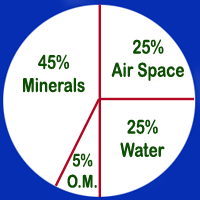 Organic matter is vital to a healthy soil. For typical
soils, the ideal composition is 25% air spaces, 25%
water pores, 45% minerals and 5% organic matter or
humus. Unfortunately, it can be difficult to maintain
these balances due to soil compaction and to the fact
that the organic matter continues to decompose in the
soil. Thus, it needs to be periodically replenished and
this can be a challenge in ornamental beds and borders.
Organic matter is vital to a healthy soil. For typical
soils, the ideal composition is 25% air spaces, 25%
water pores, 45% minerals and 5% organic matter or
humus. Unfortunately, it can be difficult to maintain
these balances due to soil compaction and to the fact
that the organic matter continues to decompose in the
soil. Thus, it needs to be periodically replenished and
this can be a challenge in ornamental beds and borders.
Fortunately, both heavy
clay and excessively sandy soils may be improved by
adding large amounts of organic matter (OM). In clay
soils, the OM will help to form larger aggregates or
clumps which then provide pore spaces generally missing
in fine textured clay. This can improve both the air
content of the soil and improve the poor drainage
typical of this type of soil.
In
sand, OM will actually
fill some of the very large pores that usually lead to
excessive drainage and droughty conditions. Also, the OM
will act as a "sponge" to absorb water and prevent it
from running swiftly through the sandy soil. The final
benefit is that OM has a great attraction to nutrients
in the soil and will hold them in the root zone of
plants. Sandy soils have little attraction to nutrient
elements and they quickly move through the soil with
water and out of the root zone of plants.
In addition to these
beneficial traits, OM also acts as a great environment
for soil organisms. Earthworms and a variety of
decomposing organisms thrive in a soil rich in OM.



